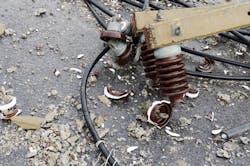We’re getting to that time of year when the media publishes its “best of” lists. I hate to be a downer, but it seems necessary to kick off the season with a “worst of” story. I’m talking about the bad year the electric grid had.
The latest grid calamity came this weekend in North Carolina where vandals in Moore County shot into substations owned by Duke Energy. As a result, 45,000 customers – almost everyone in the county – lost power, and Duke said service may not be fully restored until Thursday. Expecting freezing temperatures Sunday night, county officials imposed a curfew.
Even drag shows need microgrids
The FBI is investigating but has made no arrests as of the writing of this article. So the motive remains unknown, but there was discussion in the media about violent threats aimed at a local drag show. The New York Times reported that the show went on after the outage with cell phone flashlights and a cappella singing. When organizers realized the outage was widespread, however, they shut the show down.
The grid as an object of war
The Moore County grid attack is reminiscent of a 2013 sniper attack on the grid in San Jose, California, where someone cut nearby telephone cables and then shot out 17 transformers that served Silicon Valley. No arrests were ever made.
Such strikes on the grid are rare so more attention tends to be focused on cybersecurity threats.
That may change now that we’re seeing what happens to a 21st-century society when the electric grid becomes a war target. Russia’s bombardment of Ukraine’s grid stands out as the most devastating grid disruption of 2022. Millions of Ukrainians may face a cold winter without electricity, heat and water. Organizations offering microgrids are trying to help ensure power to medical care facilities and other critical services, but they are too few to turn things around before the winter sets in.
Storms, heat and PSPS
This year’s hurricane season was not as bad as the National Oceanic and Atmospheric Administration initially thought it might be. It fell into the normal range with 14 named storms. In the United States, the most notable was Hurricane Ian, which caused 1.6 million outages. The hurricane also demonstrated the increasing effectiveness of microgrids to keep power flowing.
In May, a derecho knocked out power to 1.2 million people in Ontario, Canada.
And then there were the garden variety winter storms where snow, ice and wind conspired to incapacitate power lines. For example, nearly 400,000 Virginia electric customers lost power in January, some for several days, in frigid weather following an ice storm.
Heat also took its toll on parts of the grid over the summer, including in Michigan, New York, Texas and California. And Californians continued to struggle with public safety power shutoffs (PSPS), which are intentional outages imposed to avert wildfires, with some even interrupting Thanksgiving plans.
And, of course, as with any system, sometimes things just break. Such was the case in Monmouth County, New Jersey, Oct. 16 when 60,000 people lost power because of a substation trip.
This article is meant to be illustrative of grid disruptions in 2022. It’s not a comprehensive list, and readers are probably thinking of times not shown here that they lost power. The point is that the electric grid is vulnerable. And that’s why we are here writing about microgrids.
Track news about microgrids. Subscribe to the free Microgrid Knowledge Newsletter.








